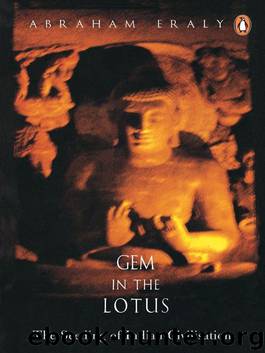Gem In The Lotus by Abraham Eraly

Author:Abraham Eraly [Eraly, Abraham]
Language: eng
Format: epub
ISBN: 9789351180142
Publisher: Penguin Books Ltd
Published: 2002-01-22T18:30:00+00:00
NOTHING LASTS. THE FINAL result of every gain and achievement and of every happiness—“the short-lived pleasure of the frightened in the arms of the frightened,” as the Dhammapada puts it—is loss and desolation and sorrow. This simple, commonplace, yet terrifying fact of life was what engaged Buddha during his many years of spiritual quest, and led him eventually to formulate the concept of the Four Noble Truths. “A withered leaf fell before him. In it he came to see the principles of decay and death,” the Jatakas state. Life is sorrow because everything in life, material as well as mental states, including life itself, is transient.
Yet hope lives eternally, eternally breeding despair. Buddha illustrated this point with the telling parable of the monkey and the pitch-trap. When a hunter sets up the trap, said Buddha, wise monkeys keep well away from it, “but a greedy, foolish monkey goes up to the pitch and handles it with one paw, and his paw sticks fast in it. Then, thinking ‘I’ll free my paw,’ he seizes it with the other paw, but that too sticks fast. To free both paws he seizes them with one foot, and that sticks fast. To free both paws and one foot, he lays hold of them with the other foot, but that too sticks fast. To free both paws and both feet, he lays hold of them with his muzzle, and that sticks fast. So, brethren, that monkey, thus caught in five ways, lies down and howls, a prey for the hunter.”
Such too is the human predicament. The pursuit of happiness does not bring happiness. All human endeavours are ultimately counterproductive. “The iron itself createth the rust which slowly consumes it,” notes the Dhammapada. As Santideva, a sixth century AD Buddhist philosopher wrote, “Eager to escape sorrow, men rush into sorrow; from desire for happiness they blindly slay their own happiness, enemies to themselves.” The consequences of all this are not confined to just this one life, but go on endlessly, life after life, as the karmic web of our own making binds us to the ever-spinning wheel of samsara.
There is no end to life. Or death. There is no end to sorrow. But how did man ever get into this predicament? The root cause, according to Buddha, is desire—tanha, he called it: thirst. “Driven on by craving men run round and round like a hunted hare,” states the Dhammapada. We are, said Buddha, held hostages for life by “the brigands of the five senses.” The answer to the problems of life, it seemed to him, was simple and obvious. Since desire is the cause of misery, the means to end misery is to snuff out desire altogether. If the candle does not burn, wax will not melt.
Buddha often compared the world to a house on fire, from which sensible people should flee. “Why this laughter, why this jubilation, when this world is burning, burning?” he demanded. Unfortunately, few see themselves as living in a house on fire, and do not therefore seek the means to escape from it.
Download
This site does not store any files on its server. We only index and link to content provided by other sites. Please contact the content providers to delete copyright contents if any and email us, we'll remove relevant links or contents immediately.
| Central Asia | Southeast Asia |
| China | Hong Kong |
| India | Japan |
| Korea | Pakistan |
| Philippines | Russia |
The Sympathizer by Viet Thanh Nguyen(4096)
The Rape of Nanking by Iris Chang(4024)
World without end by Ken Follett(3347)
Ants Among Elephants by Sujatha Gidla(3282)
Blood and Sand by Alex Von Tunzelmann(3060)
Japanese Design by Patricia J. Graham(3004)
City of Djinns: a year in Delhi by William Dalrymple(2436)
Foreign Devils on the Silk Road: The Search for the Lost Treasures of Central Asia by Peter Hopkirk(2389)
Inglorious Empire by Shashi Tharoor(2347)
The Queen of Nothing by Holly Black(2324)
In Order to Live: A North Korean Girl's Journey to Freedom by Yeonmi Park(2304)
India's Ancient Past by R.S. Sharma(2304)
Tokyo by Rob Goss(2294)
India's biggest cover-up by Dhar Anuj(2250)
Tokyo Geek's Guide: Manga, Anime, Gaming, Cosplay, Toys, Idols & More - The Ultimate Guide to Japan's Otaku Culture by Simone Gianni(2244)
The Great Game: On Secret Service in High Asia by Peter Hopkirk(2231)
Goodbye Madame Butterfly(2163)
Batik by Rudolf Smend(2010)
Living Silence in Burma by Christina Fink(1987)
